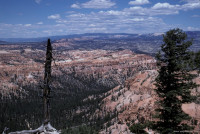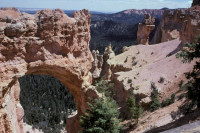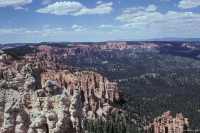|












Bryce Canyon National Park was originally settled by early Mormon pioneers and became a national park on June 8, 1923. The naturally formed amphitheaters are actually not canyons but eroded cliffs along the edge of the Paunsaugunt Plateau.
The spectacular geologic formations were sculpted into hoodoos – a spire of rock formed by frost action and erosion by water. The harder rock on top of the hoodoos is mostly responsible for the preservation of the columns. The hoodoos consist of what geologists refer to as the Claron Formation deposited between about 40 to 63 million years ago. The erosion of the area began about 16 million years ago when the Colorado Plateau began to rise from geologic processes deep within the earth. The spectacular pink, yellow, purplish, and reddish colors of the Claron Formation are primarily due to iron- and manganeses-rich minerals such as hematite, limonite, and pyrolusite.

Bryce Canyon National Park (pron.: /ˈbraɪs/) is a national park located in southwestern Utah in the United States. The major feature of the park is Bryce Canyon, which despite its name, is not a canyon but a collection of giant natural amphitheaters along the eastern side of the Paunsaugunt Plateau. Bryce is distinctive due to geological structures called hoodoos, formed by frost weathering and stream erosion of the river and lake bed sedimentary rocks. The red, orange, and white colors of the rocks provide spectacular views for park visitors. Bryce sits at a much higher elevation than nearby Zion National Park. The rim at Bryce varies from 8,000 to 9,000 feet (2,400 to 2,700 m).






 Please share your ideas with us.
Please share your ideas with us.